Landblog Main
previous archive
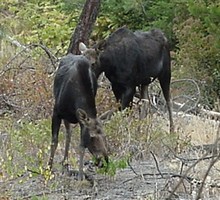 Moose! -- 14 September 06 -- What's the plural of moose? I think it's still moose. Yesterday I was sitting at the bottom of the north hill, turning a cedar tree into rough posts for the cabin, when three moose came down the hill. These two are females. They walked down cautiously, munching on yellowing ocean spray and snowberry leaves. One of them sniffed my black hawthorn and didn't eat it, probably because I sprayed it with mint-based deer repellent. Then they came all the way to the bottom and crossed right in front of me.
Moose! -- 14 September 06 -- What's the plural of moose? I think it's still moose. Yesterday I was sitting at the bottom of the north hill, turning a cedar tree into rough posts for the cabin, when three moose came down the hill. These two are females. They walked down cautiously, munching on yellowing ocean spray and snowberry leaves. One of them sniffed my black hawthorn and didn't eat it, probably because I sprayed it with mint-based deer repellent. Then they came all the way to the bottom and crossed right in front of me.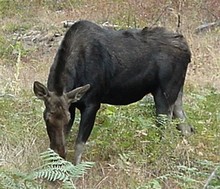 They were probably less afraid of me because I was behind a big pile of wood, and moved slowly to not startle them. I could have got better photos, but I was being too cautious with my limited number of shots, and when one of them looked right at me from only ten feet away, I'm afraid I was messing with the zoom and missed the moment. This is the closest face shot I got:
They were probably less afraid of me because I was behind a big pile of wood, and moved slowly to not startle them. I could have got better photos, but I was being too cautious with my limited number of shots, and when one of them looked right at me from only ten feet away, I'm afraid I was messing with the zoom and missed the moment. This is the closest face shot I got: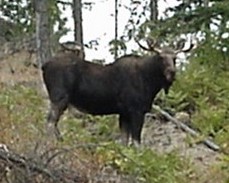 The third moose, the male, stayed halfway up the hill. The women were thinking, "Ooo, let's go meet the visitor!" and the guy was thinking, "He'll probably shoot me!" This is as close as he came. Then he went into the bushes and walked the long way around, and the females walked right through the middle of my land and up the access road.
The third moose, the male, stayed halfway up the hill. The women were thinking, "Ooo, let's go meet the visitor!" and the guy was thinking, "He'll probably shoot me!" This is as close as he came. Then he went into the bushes and walked the long way around, and the females walked right through the middle of my land and up the access road. 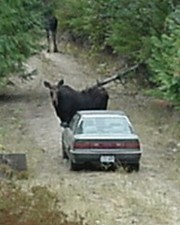 Check out how big they are:
Check out how big they are: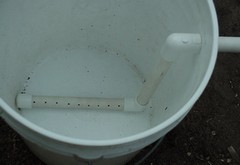 Biosand Filter -- 20 September 06 -- Earlier this summer, during Patricia's visit, I made a biosand filter for the spring water... I think. Here's a photo of the inside of the filter bucket. The pipe, joints, and cap were under $3 total at Home Depot. I just had to saw them into the right lengths and fit them together. Also I drilled the holes you see in the bottom pipe, all the way around. And where it comes out the side of the bucket, I made a big hole by first drilling a circle of little holes, then punching it out and carving it to a circle with a knife. The tricky part was how to seal where it came out -- we decided to buy some fast-drying putty.
Biosand Filter -- 20 September 06 -- Earlier this summer, during Patricia's visit, I made a biosand filter for the spring water... I think. Here's a photo of the inside of the filter bucket. The pipe, joints, and cap were under $3 total at Home Depot. I just had to saw them into the right lengths and fit them together. Also I drilled the holes you see in the bottom pipe, all the way around. And where it comes out the side of the bucket, I made a big hole by first drilling a circle of little holes, then punching it out and carving it to a circle with a knife. The tricky part was how to seal where it came out -- we decided to buy some fast-drying putty.The next tricky part was how to keep sand out of the bottom pipe. When they showed us this at the permaculture class, they put a couple inches of gravel in the bottom, enough to cover the bottom pipe, and then sand. But it seems to me that the sand would just come down through the gravel and clog the holes. So I laid a cotton handkerchief over the gravel, then I filled it with sand to just below where the pipe comes out. The idea is that if the top of the sand is always below the waterline, a "biofilm" forms on it, and that and the sand clean the water.
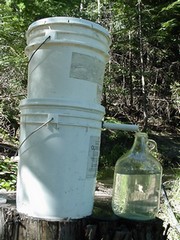 But you have to run the water through slowly, so you use a two-bucket setup, like this:
But you have to run the water through slowly, so you use a two-bucket setup, like this:I drilled seven one-eighth inch holes in the bottom of the top bucket, which was way too many, and I had to plug them with tiny rocks. Then you need about twice as many holes in the lid of the main bucket. On my filter, I just use the top bucket to dip water from the spring and then set it on the bottom bucket. But I'm not sure it's working. The only "biofilm" so far looks just like the pond algae. And when water has been sitting in the thing for a few days, it comes out smelling like a sewer! Maybe that's normal, or the right microcritters haven't colonized it yet, or I used the wrong kind of sand, or the handkerchief somehow ruined it. I ran fresh water through and drank some and didn't get sick, but I never got sick from the original water either... Please don't consider me an authority on this. If you want to know more, you can do a google search.
Felling and Splitting -- 21 September 06 -- To make the posts for my cabin, I decided to cut down a double-trunk dead cedar almost 50 feet tall. I figured I'd drop the larger trunk to the southwest, since the wind was blowing that way. But when I made the cuts, it didn't fall -- the upper branches of the two trunks were caught together, and I greatly overestimated the effect of wind on a dead leafless tree. My next plan was to drop the smaller tree to the northeast, since it was leaning slightly that way, and maybe the lean would be enough to unstick the branches. It wasn't. So finally I went up the trunk a little and re-cut the larger tree to also fall northeast.
At first I tried my giant one-man crosscut saw, which cuts about twice as fast as the little Japanese hand saws... vertically. Cutting horizontally, the blade bends under its own weight and binds in the tree and I can only go a few inches. So I ended up using the little saw for the whole job. The hard part was knowing when the tree would fall so I could get out of the way. Every time it made a noise, I ran away. At first I felt a surge of fear each time, but pretty soon it was a purely physical instinctive reaction -- hear pop, run.
It turns out that a tree pops and cracks a lot before it's close to falling. The job took me a couple weeks because I would go home thinking it was just on the edge of falling and by the time I came back, the wind would surely finish the job. It didn't, and finally I sawed until it was steadily cracking, and still had a good five seconds (enough for the fastest humans to run fifty yards) before it toppled and fell.
It landed just exactly where I was aiming it, and it was my first tree, and a tricky one. This makes me quite certain that the professional logger who felled a tree to crush an ecological activist in Oregon a few years ago is guilty of first degree murder. Anyway, now that it was on the ground, I picked out and cut some straight nine foot sections. That's how long I want my posts, 6½ feet above ground and 2½ feet below. But they were too thick, and I needed more, so I decided to split two of them.
Splitting a log is not easy! This was western redcedar, one of the easiest woods to split, and both logs already had cracks running the whole nine feet. The way you're supposed to do it is to buy special splitting wedges and a special splitting maul. I love buying tools, but I already have four axes -- I have to draw the line somewhere. So I tried using two axes as wedges, first swinging them to hit the crack, but I kept missing and damaging the future post. Then I stuck the axes in the crack and hit them with a big hammer and tugged on the handles. Didn't work. Then I stuck two axe heads close to each other, and alternately pounded them. Now I was getting somewhere... but slowly!
Then I thought, what did the Indians do? Wooden wedges! Making wedges seemed like too much work, so I just started picking up sticks and hammering them in. This was working way better than the axes, but still, after half an hour and lots of cracking noises, the log was solid.
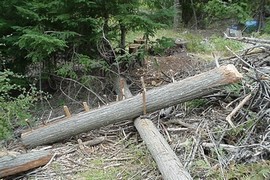 Finally, I made wedges. It doesn't take long. I found hard sticks an inch or more thick, sawed off one end, and quickly whittled the other end to a point with the mini hatchet. Each one took only a couple minutes. In the photo you can see about ten of them lined up in the crack, and above the hammer is the fresh double stump. Then I just went up and down the log hitting them like a xylophone. This was fun! And in fifteen minutes, the log was mostly split. Next time I'll also make some really thick wedges to finish the split when the crack gets too wide for the small ones.
Finally, I made wedges. It doesn't take long. I found hard sticks an inch or more thick, sawed off one end, and quickly whittled the other end to a point with the mini hatchet. Each one took only a couple minutes. In the photo you can see about ten of them lined up in the crack, and above the hammer is the fresh double stump. Then I just went up and down the log hitting them like a xylophone. This was fun! And in fifteen minutes, the log was mostly split. Next time I'll also make some really thick wedges to finish the split when the crack gets too wide for the small ones.Everything at Once -- 26 September 06 -- My housesit is ending, so this was my last chance to haul stuff up to the land until late October, and by then the roads may not be passable with 2wd. So I loaded up the car with various scraps, lots of stuff for the compost pile, and 110 pounds of Mount St Helens ash...
On the fringes of permaculture, some people think powdered rock, or glacial dust, can turn any landscape into Eden. There's even a theory that ice ages periodially restore the fertility of the Earth when glaciers grind mountains into magic dust. Anyway, plants do seem to love it, and 26 years ago, eastern Washington was covered by up to two inches of the stuff when Mount St Helens exploded. We got about an inch in Pullman, got out of school early, and spent weeks hosing it off our driveways and roofs, and getting permanent lung damage. Some people saved it in case it was ever valuable... and it still isn't. A couple weeks ago I saw a Craigslist posting giving a bunch away, and when I finally got around to emailing, it was still there, and I snagged a garbage can full of the stuff.
Also, my friend Eula was passing through town and drove up with me. Around noon on Sunday, we were halfway through hauling the stuff from the car up to the camp, when some people walked down the access road...
I have neighbors! The plot south of me has sold. The buyers are a couple about my age who work at some tech company in Spokane, and they were up with about four other people whose connection I forgot, along with most of their names. But they seem nice. They're buying the land as a summer getaway and paintball range, and might grow some food too, so I'll try to motivate them to make a little orchard in the south-facing slope below the cabin. Anyway, I spent an hour showing them the corner posts and walking all along the property line with bare feet, so they're already thinking of me as an eccentric.
Then Eula spent some time interviewing me for a documentary she's making, and we had to finish hauling stuff and setting up camp, so it was mid-afternoon before I started working. We deepened some holes, I watered everything, and then I made my big mistake. In June, a ponderosa pine on the north hill fell over, and I was determined to save the wood and use it. It was long and straight, seemingly perfect for my cabin beams. So I spent hours sawing it up and moving it around and stripping the bark... only to discover that three months is too long to wait! Critters had already eaten holes all through the wood, which probably improves it as firewood, but ruins it for beams.
I should have left it to rot, and spent the whole trip on the orchard. Instead, I hurried too much, got too tired, got a lot of extra scrapes, strained my back a little, and didn't do half of the digging that I needed to. With the sun getting low on Monday, I didn't even have the time or energy to finish taking the tents down. Hopefully I'll get one more visit before I go to Seattle, and I can get the holes closer to ready for fall planting at the end of October.
Fall Planting -- 4 November 06 -- Everyone agrees that planting seedlings in the spring is good, but there's no consensus on fall planting. Some people say it's better because the plant has an extra five months to dig its roots into the soil before it has to get through a dry summer. Some people say it's worse because the plant is more at risk from frost heave and critters. I had to try it. When in doubt, I always prefer to experiment and find out what I can get away with. First hand experience is more expensive than second hand experience, but it's worth the price if you can afford it.
So this year I made a fall order from St. Lawrence, currently my favorite nursery because everything I planted from them in spring is still alive. The package must have been delivered Wednesday afternoon but I didn't notice it on the porch until Thursday morning. Immediately I checked the weather, saw that snow was coming, and quickly packed the car and drove up to the land. On the way I bought some super-stinky chicken manure compost, and when I got there I parked at the high point on the access road, in case it snowed so bad that the car couldn't get back up the hill.
I had sixteen seedlings. First, near the entrance to the land, downhill from the rest of the orchard, six black walnuts. In pre-industrial times, walnuts were a sign of the foresight and dedication of a landowner, because a mature walnut is just about the most valuable tree you can have, but you have to wait a few decades. I figure I'll eventually use four of them for wood and keep two for nuts.
Then I had two Bali cherry trees (a much-recommended cold-hardy tart cherry), two "hazelberts" (which may or may not pollinate my Barcelona hazel), a Centennial crabapple, and five unsexed sea buckthorns, a plant that should thrive on my land but they keep dying -- either because the ones from Burnt Ridge nursery are no good, or because I planted them in a bad place. This time I'm trying a new nursery and a new location, making a hedge across the west hill just above the apple trees. With any luck, at least two of them will be males and I'll switch out the others with named variety females.
I already knew exactly where everything was going to go, and I had holes dug, with piles of loose dirt next to them, which I would put back in the holes around the roots, mixed with compost and nearby topsoil. One problem: when I got there, the previous two nights the temperature had dropped below 15°F (-10°C). The piles of dirt were frozen hard! I worked at it for a bit with the shovel, and finally went and got the pick, and ended up filling the holes with a mixture of chicken compost and frozen chunks of dirt. Part way through the job, it started to snow.
 Here's my land under a quarter inch of snow, looking north from the middle of the road near the southeast corner. This was falling while I was running around chopping frozen dirt and filling holes and hauling water around, which inevitably splashed on my pants. But the nice thing about snow is that it reflects light and extends useful daylight far into dusk. I had time to get everything planted and watered, make a nice meal with grass-fed beef and grocery outlet pasta sauce, and get into bed on an old car seat mattress with one sleeping bag under me and two on top.
Here's my land under a quarter inch of snow, looking north from the middle of the road near the southeast corner. This was falling while I was running around chopping frozen dirt and filling holes and hauling water around, which inevitably splashed on my pants. But the nice thing about snow is that it reflects light and extends useful daylight far into dusk. I had time to get everything planted and watered, make a nice meal with grass-fed beef and grocery outlet pasta sauce, and get into bed on an old car seat mattress with one sleeping bag under me and two on top.In the night the snow turned to rain and on the ground it turned to slush. In the morning I went around and mulched everything with dead bracken ferns, but didn't water any more since there's a ton of rain coming. Driving out, the road was already full of huge puddles. A couple more days and I wouldn't have been able to drive in.